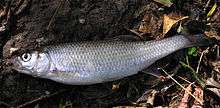Common dace
| Common dace | |
|---|---|
 | |
 | |
| Scientific classification | |
| Kingdom: | Animalia |
| Phylum: | Chordata |
| Class: | Actinopterygii |
| Order: | Cypriniformes |
| Family: | Cyprinidae |
| Genus: | Leuciscus |
| Species: | L. leuciscus |
| Binomial name | |
| Leuciscus leuciscus (Linnaeus, 1758) | |
The common dace (Leuciscus leuciscus), the dace or the Eurasian dace, is a fresh- or brackish-water fish belonging to the family Cyprinidae. It is an inhabitant of the rivers and streams of Europe north of the Alps as well as in Northern Asia. It is abundant in much of its range, and has also spread to Ireland where it is used as a bait fish. It will grow to a maximum length of 40 cm (1 ft 4 in), a maximum weight of 1 kg (2.2 lb), and may live for up to 16 years.
The common dace natively lives in a temperate climate and prefers water with a 6.0 to 8.0 pH and an ideal temperature range of 4 to 22 °C (39–72 °F). It prefers clear streams flowing over a gravelly bottom, and deep, still water, keeping close to the bottom in winter, but disporting itself near the surface in the sunshine of summer. It is preyed upon by the larger predaceous fishes of fresh waters, and owing to its silvery appearance is a favourite bait in pike angling. Its flesh is wholesome and is sometimes caught for food, but is not held in much estimation. While typically a freshwater fish, the dace enters brackish waters in the eastern Baltic Sea.
The dace is a lively, active fish, of gregarious habits, and exceedingly prolific, depositing its pale yellow eggs in the spring at the roots of aquatic plants or in the gravelly beds of the shallow, flowing streams it frequents. It poses a risk as a potential pest in some areas. In appearance it closely resembles the roach in both size and shape, with the head and back of a dusky blue color and the sides of a shining silvery aspect, with numerous dark lines running along the course of the scales. The ventral and anal fins are white, tinged with pale red, and the dorsal, pectoral and caudal tipped with black. The dace feeds on worms, insects, insect-larvae, snails, and also vegetable matter, albeit rarely.
In the United States, the name of dace is also applied to members of other genera of the family; the horned dace is a well-known species.
In angling, the dace is known to respond to dry flies, particularly in the summer months.
See also
- Fried dace with salted black beans, made from a different fish
References
- Freyhof, J. (2011). "Leuciscus leuciscus". IUCN Red List of Threatened Species. Version 2013.2. International Union for Conservation of Nature. Retrieved 18 May 2014.
- "Leuciscus leuciscus". Integrated Taxonomic Information System. Retrieved 4 October 2004.
- Froese, Rainer, and Daniel Pauly, eds. (2004). Leuciscus leuciscus in FishBase. September 2004 version.
 This article incorporates text from a publication now in the public domain: Chisholm, Hugh, ed. (1911). "article name needed". Encyclopædia Britannica (11th ed.). Cambridge University Press.
This article incorporates text from a publication now in the public domain: Chisholm, Hugh, ed. (1911). "article name needed". Encyclopædia Britannica (11th ed.). Cambridge University Press.
External links
 Media related to Common dace at Wikimedia Commons
Media related to Common dace at Wikimedia Commons- Dace (Leuciscus leuciscus) media at ARKive

